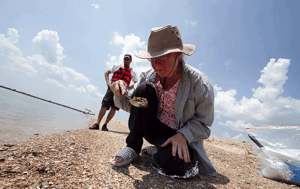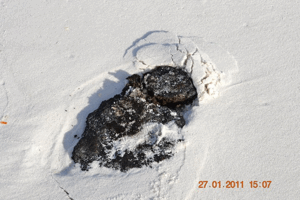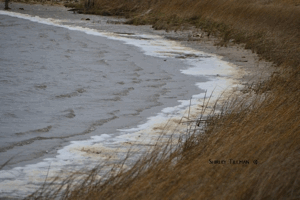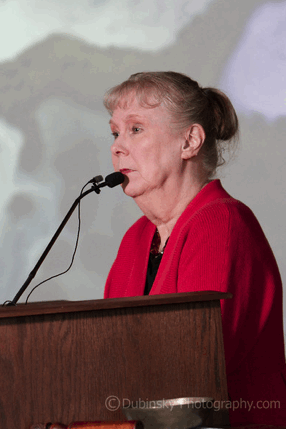Toxic Tide: Discovering the Health Effects of the Deepwater Disaster
Air Date: Week of February 11, 2011

Wilma Subra looking at sand samples from the Gulf Coast. (Photo: Jeffrey Dubinsky)
Months after BP's well was capped, the health effects of the Deepwater Horizon oil spill may just be starting to surface. Residents across the Gulf Coast report mysterious ailments, and some blood samples show traces of chemicals related to the oil. But as Living on Earth's Jeff Young reports, firm answers are hard to come by and frustration is growing in coastal communities.
Transcript
GELLERMAN: ItÂ’s Living on Earth, IÂ’m Bruce Gellerman. ItÂ’s been more than six months since BP finally capped its runaway oil well in the Gulf of Mexico. But now come reports of a wave of illnesses and puzzling symptoms from some residents along the Gulf Coast. Their blood contains high levels of chemicals found in oil and the dispersants that were used to clean up the mess.
Many who are suffering say firm answers and adequate treatment are hard to come by, and thereÂ’s a growing sense of frustration with government agencies and the medical community. Living on EarthÂ’s Jeff Young has the first part of our special report: "Toxic Tide - Discovering the Health Effects of the Deepwater Disaster".
[HEARING: OIL SPILL COMMISSIONER DON BOESCH Okay, questions and comments from the floorÂ…]
YOUNG: When the National Oil Spill Commission presented its final report in New Orleans, commissioners expected to get an earful from rig workers and fishermen worried about their jobs. Instead they heard speaker after speaker worried about something else: their health.
SPEAKER 1: I worked 60 days on the frontline for BP out here. IÂ’m sick today, nobody wants to take care of me.
SPEAKER 2: The issue is ongoing; people are getting sick and dying.
SPEAKER 3: I have seen small children with lesions all over their body. We are very, very ill. And thereÂ’s a very good chance now that I wonÂ’t get to see my grandbabies.
YOUNG: Some had worked cleaning up the oil, others lived in or had visited places where oil washed ashore. All complained of mysterious ailments that arose after the spill.

ChildrenÂ’s footprints in the oily sand along the Alabama coast. (Photo: Jerry Cope)
Robin Young was one of those who spoke out. She manages vacation rental properties in Orange Beach, Alabama, where she has lived for 10 years.
When the spill started, Young helped form a citizen group called Guardians of the Gulf. At first, the group was not focused on health issues. Then, people, including Young, started getting sick.
R YOUNG: Headaches, I would get nauseous - and these are all things that I donÂ’t normally experience at all, IÂ’ve always been very, very, very healthy. Then the coughing - I coughed up so much nasty looking mess.
J YOUNG: Young says symptoms started after she spent a day near the water in June and she still hasnÂ’t fully recovered. She heard from others in her community and across the Gulf coast with similar problems.

Tarballs of BP crude still come ashore when winter storms stir up the GulfÂ’s remaining spilled oil. (Photo: Jerry Cope)
R YOUNG: We have way too many people that are sick with very odd symptoms that they have never experienced before in their life. So thereÂ’s something going on! And itÂ’s all the way up and down the coast and it seems to be in the predominant areas where the oil continues to come onshore.
J YOUNG: A number of people Young contacted sought treatment just across the state line in Santa Rosa Beach, Florida, with Dr. Rodney Soto. Dr. Soto says heÂ’s seeing a lot of upper respiratory symptoms and severe rashes.
SOTO: Multiple lesions all over their bodies and bruising. I tell you, people are suffering a great degree. The stress level is through the roof. So we are barely scratching the surface in regards to what else we are going to see and I donÂ’t think the medical community is well prepared to handle this.
J YOUNG: Dr. Soto says the symptoms, patient histories and, in some cases, blood samples indicate these illnesses are likely due to chemical exposure from the spill. But back on the Alabama coast, thereÂ’s skepticism about that. Tony Kinnon is mayor of Orange Beach.
KINNON: I would not doubt that these people are ill. But I would say for them to adamantly say the oil spill made them ill - theyÂ’re gonna have to present evidence.
YOUNG: Kinnon says the city contracted an independent engineering firm to sample air water and soil. And he says local physicians have not reported any unusual number of health issues that might be oil-related. He says he wants to protect peopleÂ’s health and peopleÂ’s jobs.

Gulf Coast residents say this foamy mixture of oil and dispersants still comes up in the waves. (Photo: Shirley Tillman)
KINNON: WeÂ’re a tourism industry. And I donÂ’t know if you can remember that old scene in the movie Jaws where the mayor is standing on the beach saying "Come on to the beach, thereÂ’s no shark in the water!" and, heh, you look in the water and thereÂ’s blood everywhere!
YOUNG: You donÂ’t want to be that guy!
KINNON: ThatÂ’s exactly right. So you know, I want people to know that when I say we are healthy, the water and our beaches are fine - itÂ’s because we did our homework.
YOUNG: State health departments in Alabama, Florida, Louisiana and Mississippi set up surveillance systems with emergency rooms and health clinics. There is little in that data to suggest a large number of spill-related illness. But Dr. Rodney Soto says chemical exposure cases can fall through the cracks if physicians are not trained to detect them because the symptoms mimic other illnesses.
SOTO: The diagnoses in their records are gonna be cold, flu, weakness, immune problem, whatever they want to call it. And so the government agencies are not gonna pick up on anything because there is no report or no documentation in the records.
YOUNG: Dr. Soto suspects many people who lack health insurance are trying to treat their own symptoms with over-the-counter medicines. And worse, Dr Soto says, some physicians might be willfully turning a blind eye.
SOTO: And, unfortunately, IÂ’m hearing a lot from patients that their doctors are turning them away. They, for whatever reason, donÂ’t want to get involved with dealing with this connection of oil to illness. Whether itÂ’s litigation, or whether itÂ’s BP, who knows what their motivations are. Somebody specifically told me the doctor said "We donÂ’t want to see any patients who potentially have symptoms of oil spill, period."
YOUNG: Some of Dr. SotoÂ’s patients are having their blood samples analyzed for traces of volatile organic compounds that might indicate oil exposure. Robin Young had her blood tested.
RYOUNG: They found that I had ethylbenzene, isooctane, 2-butyrol, 3-butyrol, the hexane levels were over the top – so the lab even put a big H by it. It was scary; it was depressing. And then I got mad.

Biochemist Wilma Subra presents results of her analysis of blood samples to community members in Louisiana. “There’s a lot of frustration in communities.” Subra said. “They are really requesting answers.” (Photo: Jeffrey Dubinsky)
J YOUNG: YoungÂ’s group paid for more blood sampling. The Louisiana Environmental Action network asked biochemist and MacArthur grant winner Wilma Subra to analyze the results. The blood samples came from cleanup workers, crabbers, a diver whoÂ’d been in oiled water, and at least two children who live on the coast. All had reported recent health problems. Subra compared the levels of volatile organic compounds in those samples to a national database of VOCÂ’s in blood compiled by the National Center for Health Statistics.
SUBRA: TheyÂ’re as much as 5 to 10 times what youÂ’d find in the normal population. And again, these are chemicals that relate back to chemicals in the BP crude and the dispersants.
YOUNG: Benzene is a carcinogen and is linked to immune system problems and a host of illnesses. Ethylbenzene can cause dizziness and kidney damage. Xylene can cause headaches, rashes and respiratory problems.
But this blood sampling alone does not prove a connection between the illnesses and the oil. ItÂ’s a small number of people - just a few dozen. Many of the chemicals rapidly break down and are hard to track. And other routes of exposure might be to blame. Benzene can come from pumping gasoline, breathing paint fumes, vehicle exhaust, or cigarette smoke. But Subra defends her findings and wants health officials to use her data to guide further study and treatment.
SUBRA: I think itÂ’s demonstrating that the chemicals they are being exposed to are showing up in their blood. WeÂ’ve briefed the federal agencies on it, tried to get them interested - they are evaluating the results. And I think thereÂ’s a lot of frustration in the community members across the coastal areas. They are really requesting answers.

Wilma Subra looking at sand samples from the Gulf Coast. (Photo: Jeffrey Dubinsky)
YOUNG: Solid answers will take time. ThereÂ’s little in the scientific literature on long term health effects of oil spills. In March the National Institute of Environmental Health Sciences plans to start enrolling Gulf spill cleanup workers in a long-term health study. The principal investigator is Dale Sandler, chief of epidemiology at NIEHS. She hopes to track some 55,000 subjects for at least five years.
SANDLER: This will be by far the largest study of individuals exposed during an oil spill disaster thatÂ’s ever been conducted. So we have been moving heaven and earth to make this go quickly.
YOUNG: SandlerÂ’s study has funding, thanks in part to BP. The study is a few months behind its original schedule. But researchers face another hurdle that may prove more difficult. Signing up tens of thousands of participants and getting people to accept results depends on credibility and trust. After the BP spill and Hurricane Katrina, trust is in low supply on the Gulf Coast. HereÂ’s how Orange Beach Mayor Tony Kinnon sums up the attitude.
KINNON: The bottom line is very few people trust governmental agencies. They think thereÂ’s this incestuous relationship between BP and the government, and I tend to agree with them.
J YOUNG: And even as Robin Young asks the government to help her community, the plea comes with a note of deep suspicion.
RYOUNG: I hate to sound like a conspiracy theorist - thatÂ’s what IÂ’m starting to feel like. Because itÂ’s hard to believe that something like this is going on in the United States and no oneÂ’s helping.
J YOUNG: Those hoping to find the Gulf spillÂ’s real impact will also have to find a way to bridge a gulf of mistrust. For Living on Earth, IÂ’m Jeff Young.
GELLERMAN: Our special report: "Toxic Tide - Discovering the Health Effects of the Deepwater Disaster" continues next week with JeffÂ’s report on a key scientific finding in the GulfÂ’s air and water.
KALTOFEN: And thatÂ’s where we found something very interesting. It was not the crude oil that was responsible for most of the volatile compounds weÂ’re seeing, but it was actually the dispersant.
GELLERMAN: ThatÂ’s next week on Living on Earth.
Links
The NIEHS plan for a large-scale, long-term study of cleanup workers.
Living on Earth wants to hear from you!
Living on Earth
62 Calef Highway, Suite 212
Lee, NH 03861
Telephone: 617-287-4121
E-mail: comments@loe.org
Newsletter [Click here]
Donate to Living on Earth!
Living on Earth is an independent media program and relies entirely on contributions from listeners and institutions supporting public service. Please donate now to preserve an independent environmental voice.
NewsletterLiving on Earth offers a weekly delivery of the show's rundown to your mailbox. Sign up for our newsletter today!
 Sailors For The Sea: Be the change you want to sea.
Sailors For The Sea: Be the change you want to sea.
 The Grantham Foundation for the Protection of the Environment: Committed to protecting and improving the health of the global environment.
The Grantham Foundation for the Protection of the Environment: Committed to protecting and improving the health of the global environment.
 Contribute to Living on Earth and receive, as our gift to you, an archival print of one of Mark Seth Lender's extraordinary wildlife photographs. Follow the link to see Mark's current collection of photographs.
Contribute to Living on Earth and receive, as our gift to you, an archival print of one of Mark Seth Lender's extraordinary wildlife photographs. Follow the link to see Mark's current collection of photographs.
 Buy a signed copy of Mark Seth Lender's book Smeagull the Seagull & support Living on Earth
Buy a signed copy of Mark Seth Lender's book Smeagull the Seagull & support Living on Earth

